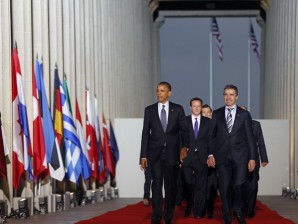NATO activates missile shield, reaches out to Russia
CHICAGO – NATO leaders launched Sunday the first phase of a US-led missile shield for Europe and sought to appease Russian anger over the system by renewing an invitation to cooperate.

President Barack Obama, left, walks out with NATO Secretary General Anders Fogh Rasmussen, right, and British Prime Minister David Cameron, center, for the NATO family photo at Soldier Field at the NATO Summit in Chicago, Sunday, May 20, 2012. AP/Pablo Martinez Monsivais
President Barack Obama and his allies declared an “interim capability” at a Chicago summit, putting a US warship carrying interceptors in the Mediterranean and a Turkey-based radar system under NATO command in a German base.
The alliance insists that the shield is not aimed at Russia and aims to knock out missiles that could be launched by enemies such as Iran, but Moscow fears the system will also serve to neutralize its nuclear deterrent.
“We have invited Russia to cooperate on missile defense and this invitation still stands,” NATO Secretary General Anders Fogh Rasmussen told a news conference.
“We will continue our dialogue with Russia and I hope that at a certain stage Russia will realize that it is in our common interest to cooperate on missile defense,” he said.
Stressing that NATO must be able to defend itself against missile threats, Rasmussen said the move “cannot be blocked by Russia, it’s a NATO decision.”
Article continues after this advertisementIn a threat reminiscent of the Cold War, Russia has warned it may respond to the NATO system by stationing short-range Iskander missiles in its Kaliningrad exclave near Poland, a European Union and NATO member state.
Article continues after this advertisementThe standoff has tested Russian-US relations for much of the past decade and been one of the primary issues addressed by Obama when he launched a diplomatic “reset” with Moscow in 2009.
NATO had hoped that Russian President Vladimir Putin would come to Chicago, but instead he sent a lower level delegation to represent Moscow during the summit’s discussion on Afghanistan.
Putin, who returned to power after succeeding his protege Dmitry Medvedev this month, was often at odds with the previous US administration over missile defense in his first two terms of office.
“Russia is sensitive about its nuclear capability because that’s what makes it a superpower,” said Nick Witney, a London-based defense expert at the European Council on Foreign Relations.
In a bid to appease its former Cold War foe, the Western military alliance offered to cooperate with Russian on missile defense at the last summit in November 2010 in Lisbon, but the two sides have struggled to find common ground.
“This is not a project targeted against Russia, but a project we want to push forward with Russia in the interest of Europe’s security,” said German Foreign Minister Guido Westerwelle. “And therefore the door for Russia will stay open.”
NATO leaders, in a declaration on its nuclear Deterrence and Defense Posture Review, reaffirmed that missile defense “is not oriented against Russia nor does it have the capability to undermine Russia’s strategic deterrent.”
The first phase will only give the alliance a very limited defense against rogue missiles. The system is being rolled out in four phases and will become fully operational by 2018.
Spain will host four US Aegis ships at its port in Rota while Poland and Romania have agreed to host US land-based SM-3 missiles in the coming years.
Moscow has called for joint control over the system and for NATO to sign a legally-binding guarantee that it is not aimed at Russia.
But NATO has balked at both demands, insisting on keeping two separate systems and refusing to sign a legally-binding document. Instead, the alliance has offered to share sensitive data with Russia.
The US election also appears to have affected the pace of negotiations.
An open microphone famously caught Obama telling then president Medvedev in March that he could negotiate some concessions on the system if Russia gave him “space” until after the election this year.